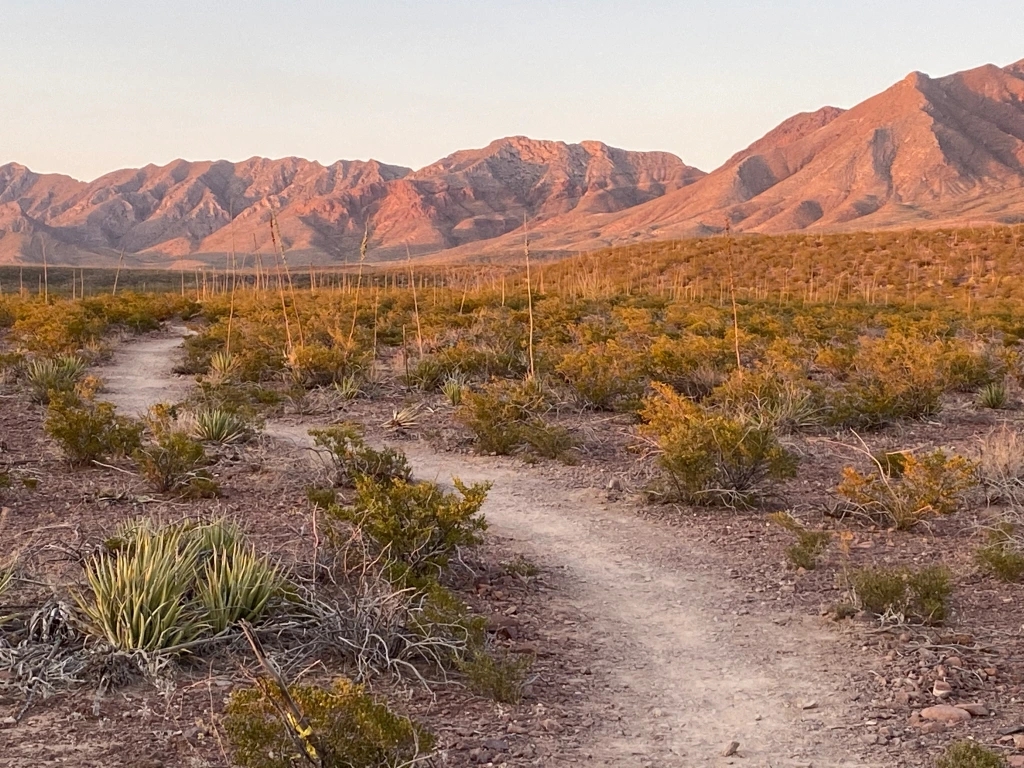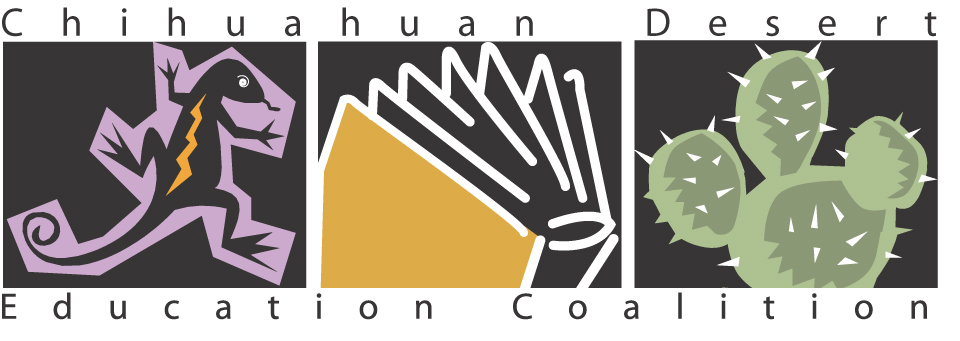
Creosote bush and lechuguilla dominate the landscape along the Lost Dog Trail.
Enjoy reading about our amazing Chihuahuan Desert. Sign up for a free subscription to our blog
The creosote bush (Larrea tridentata) is emblematic of the American southwest and Mexico, occurring in vast monospecific (one species) stands across thousands of square miles of the Chihuahuan, Sonoran, and Mojave Deserts. The Mexican common name for the plant is “gobernadora” and is sometimes referred to as chaparral in the US. Creosote bush is a member of the Zygophyllaceae, or caltrop family. This family has around 285 species in 22 genera and typically has opposite leaves with stipules or spines. Creosote can be solitary or clonal and live for thousands of years. The “King Clone” stand in the Mojave Desert of California has been determined to be 11,700 years old, making it one of the oldest organisms on Earth.
Larrea tridentata is an evergreen shrub reaching heights of 10 feet or more with yellow flowers emerging after heavy rains. The plant gives off a powerful aromatic scent after rain that is reminiscent of coal tar creosote, hence the common name.
Native Americans have used creosote bush for thousands of years to treat infections, as an anti-inflammatory, for respiratory complaints, to treat gastrointestinal disorders, as a poultice for the treatment of cuts and skin disorders, as well as for general oral health and toothaches. Indigenous peoples also used the sticky secretions of the lac scale insect, Tachardiella larreae, that lives solely on creosote bush, for medicinal and utilitarian purposes as well.

Creosote bush is a keystone species of the American warm deserts, offering food to many animals including specialist herbivores and pollinators. The jackrabbit is the only known mammal to feed directly on the leaves of the plant. Other small mammals, including wood rats and kangaroo rats, as well as countless species of birds, depend on the seeds of the creosote bush for their survival, and have no doubt helped spread the plant across the deserts.
Countless species use the plant for shelter from the desert heat or as protection from predators. More than 60 different species of insects have evolved specifically with the creosote bush. One interesting example is a walking stick insect that looks like the leaves of the bush when young and then when older, looks like the twigs of the plant. There are at least 15 distinct species of gall midges in the genus Asphondylia that form unique and complex galls on the leaves, buds, and twigs of the creosote bush. These galls are irregular plant growth formed by an immune response to the growth regulating chemicals produced by these insects. The midges then lay their eggs in the galls to complete their life cycles. Twenty-two species of native bees have evolved to feed only on the nectar and pollen of creosote bushes.
The chuckwalla lizard is the only known reptile to feed on the leaves of the plant, but countless other reptiles use it for shelter. You can see from the myriad ecological connections why the creosote bush is said to hold the desert web of life together.
Larrea is a New World genus of plants, meaning it only occurs in North and South America. Four species of Larrea occur in xeric portions of South America and one, Larrea tridentata, occurs in North America. Creosote bush is considered to be a classic example of a polyploidy complex. Polyploidy, or whole-genome multiplication, is when a normally diploid organism acquires one or more additional sets of chromosomes. Polyploidy plays a critical role in plant evolution, producing novel characteristics that aid in adaptation and single-step speciation. For instance, if a polyploid seed is dispersed to a novel environment, the extra chromosomes increase the chances of the plant developing advantageous mutations that could help it survive. Some polyploid plants can even become entirely new species altogether in a single generation. Polyploidy is a major contributor the botanical dominance of flowering plants on Earth.
Larrea tridentata is a monophyletic group that is most closely related to the South American Larrea divaricata. At one point, the two plants were considered to be one species until genetic research made a pretty compelling argument for separating them. The argument stems from the polyploidy of the creosote bush. The general theory is that long distance dispersal of seeds is responsible for bringing creosote bush to the Chihuahuan Desert, and from there, the plant spread to the other warm deserts of North America. Interestingly, ploidy levels generally conform along desert boundaries. The Chihuahuan Desert plants are diploid (2), the Sonoran Desert plants are tetraploid (4), and the Mojave Desert plants are hexaploid (6).
The DNA evidence shows that the migration of plants from the Chihuahuan to the Sonoran was facilitated by a doubling of their chromosomes. Because the Mojave and Sonoran are more similar than the Chihuahuan and the Sonoran, the boundary between tetraploid and hexaploid populations is less well defined than between diploid and tetraploid populations. Tetraploid and hexaploid genetic sequences are also nearly identical when compared with diploid DNA. In summary, creosote bush made it to the Chihuahuan Desert via long distance seed dispersal, then became tetraploid to adapt to the conditions of the Sonoran Desert, then became hexaploid to adapt to the Mojave Desert.
All this to say, the creosote invasion of the North American continent was a “recent and rapid demographic expansion from a small founding population.” Recent and rapid are both relative terms of course. It is estimated, although no one really knows for sure, that the colonization event began sometime between the mid-Pleistocene and the late Pliocene. Whenever it occurred, the addition of Larrea tridentata to the desert landscape was certainly a benefit ecologically and anthropologically.
Honestly, before researching for this article, I was not particularly impressed by the creosote bush. Yeah, it’s got cool flowers. Yeah, to me it smells weird. But, if you talk to people who have spent their lives in the desert, they will tell you that it makes the air smell heavenly when the desert gets its summertime rains. Yeah, it seems to be EVERYWHERE – up to about 5,000 ft. elevation. Now, I have a newfound interest, respect, and appreciation. I hope this article has done the same for you. I think perhaps life is like that. I will leave you with a quote by Henry Miller, “The moment one gives close attention to anything, even a blade of grass, it becomes a mysterious, awesome, indescribably magnificent world in itself.”
by Seth Hamby, Head Gardener, at the Chihuahuan Desert Research Institute, CDRI Nature Center & Botanical Gardens

Photos by Rick LoBello

